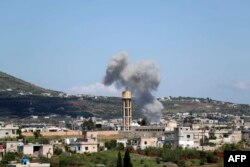Syrian and Russian warplanes have been escalating airstrikes on the last remaining rebel redoubt in northern Syria. The air raids are as much a message to Turkey as to die-hard rebels and jihadists in the province of Idlib, say analysts.
Russia wants Turkey to do more to remove from the province jihadists fighters once affiliated with al-Qaida, they say.
The U.N. is calling for de-escalation in northwestern Syria, with Secretary-General Antonio Guterres urging all parties to recommit to a truce covering opposition-held parts of Idlib, western Aleppo and northern Hama. More than 2.7 million people live in the rebel redoubt, many displaced from other parts of the war-wrecked country.
The Office of the U.N. High Commissioner for Human Rights (OHCHR) said at least 27 civilians have been killed and 31 injured since April 29, including women and children.
Turkey, which backs moderate Syrian rebels and has been in alliance with them against the Syrian Kurds, agreed in September to disarm and remove fighters in the hardline Hay'at Tahrir al-Sham faction. That armed group, once formerly affiliated with al-Qaida, has been expanding its control over parts of Idlib.
Activists say 43 combatants and five civilians were killed on Monday alone in the stepped up airstrikes that reportedly have included dropping barrel and incendiary bombs on residential areas. U.N. officials say the use of barrel bombs in the last few days is the worst they’ve seen by the Syrian army in the 15 months since an agreed to cease-fire for Idlib, which shares a 130-kilometer border with Turkey.
Two medical facilities were also reportedly damaged Monday, bringing to 12 the number of medical clinics bombed since April 28. Relief workers say the bombings occurred despite their coordinates having been shared with the warring parties through a U.N. deconfliction mechanism.
Aerial attacks have targeted the city of Jisr al-Shughour and the al-Ghab plain, as well as the towns of al-Latamenah and Maarat al-Numan in the south of Idlib province, rebels say.
A 15-kilometer demilitarized buffer zone was established along the front lines separating the opposition and forces loyal to Syrian President Bashar al-Assad last September in a deal between the leaders of Russia and Turkey. The move shelved a threatened all-out assault by the Russia-backed Assad government on Syria's last rebel stronghold.
Under the terms of the deal, all “radical fighters” would withdraw and all opposition factions would remove heavy weaponry from the zone. By the end of 2018, transportation routes between Syria's port of Latakia with Aleppo and Hama were meant to have been restored.
Rebel leaders say the military objective of the intensified airstrikes appears to be aimed at seizing control of highways M5 and M4. But they are warning also the air blitz may herald the start of a final government offensive on the rebel enclave, much as intense bombing did in 2016 before a successful government assault on Aleppo.
“An offensive will happen sooner rather than later. It's just difficult to say how soon,” according to Ahmad Rahal, a former rebel commander.
On Monday, government troops and allied Iran-backed militiamen captured a string of opposition-held villages in northern Hama. Rebel factions carried out counter-attacks in neighboring Latakia province and launched some weaponized drone attacks on the Russian airbase at Hmeimim.
Analysts at the Institute for the Study of War say the government forces appear to be setting the conditions for only a limited ground attack mainly focused on the southern Idlib and northern Hama countryside. Armored units have been deployed, according to Syrian government news reports.
Russian President Vladimir Putin has said it is unlikely that a full-scale assault on Syria’s Idlib province will be mounted, dismissing it as impractical for now, although he has not ruled it out entirely. The political aim of the intensified airstrikes appears aimed at putting pressure on Turkey to fulfill its side of the demilitarized zone deal.
Whatever the objectives, the human cost is mounting. U.N. agencies such as the Office of the High Commissioner for Human Rights estimate that tens of thousands are fleeing and relief workers are warning of an “apocalyptic” humanitarian disaster.
OHCHR spokeswoman Ravina Shamdasani said, "We call on all parties to the conflict to respect the international humanitarian law principles of distinction, precaution and proportionality and to ensure the full protection of civilian objects.”
“This blatant aggression has forced well over 300,000 people out of their homes and did not stop even on the first day of the holy month of Ramadan,” rebel leaders say. In a statement issued Tuesday, the Syrian Coalition, the main umbrella opposition group, said, “The fierce Russian airstrikes and the regime’s heavy artillery shelling are directly targeting residential areas.”














